This research is first of a four part series on country demographics for the European Union, Japan, China and the United States. Please enjoy and share.
ab
The European Union is on the brink of a demographic implosion. With its aging population and declining birth rates, the EU is rapidly becoming a gray society with a gray economic future. This shift in population dynamics – marked by fewer young citizens and a growing elderly population – is having a profound impact on the social, economic, and political landscape of the region. Slower economic growth, higher government spending on healthcare and pensions, and a lack of opportunities for the younger workers are all likely in the future.
In this article, we delve into the core of the matter, exploring the underlying causes and the potential implications of this demographic shift. We’ll take you through the complexities of the EU’s graying society and uncover the opportunities and challenges that lie ahead. This situation is a slow-moving train wreck that can be avoided with making the right public policy moves today for economic growth in the future.
It should remind everyone of what is happening, or not, with climate mitigation and adaptation. The longer the time it takes before changes are made, the more likely bigger and more difficult changes will be needed. A taste of this challenge is occurring in France now as the Macron government attempts to raise the retirement age by 2 years from 62 to 64.
Population Trends and Demographics Prior to the Pandemic
Pre-Pandemic Demographics in the EU as a Whole
The total population in the EU has been steadily growing prior to the impact of the pandemic, as shown in Figure 1 below. Over the past two decades, the number of people living in the EU grew by 4.4% percent, from 428.5 million on 1 January 2000 to 447.5 million on 1 January 2020, or at an average annual growth rate of 0.21%.
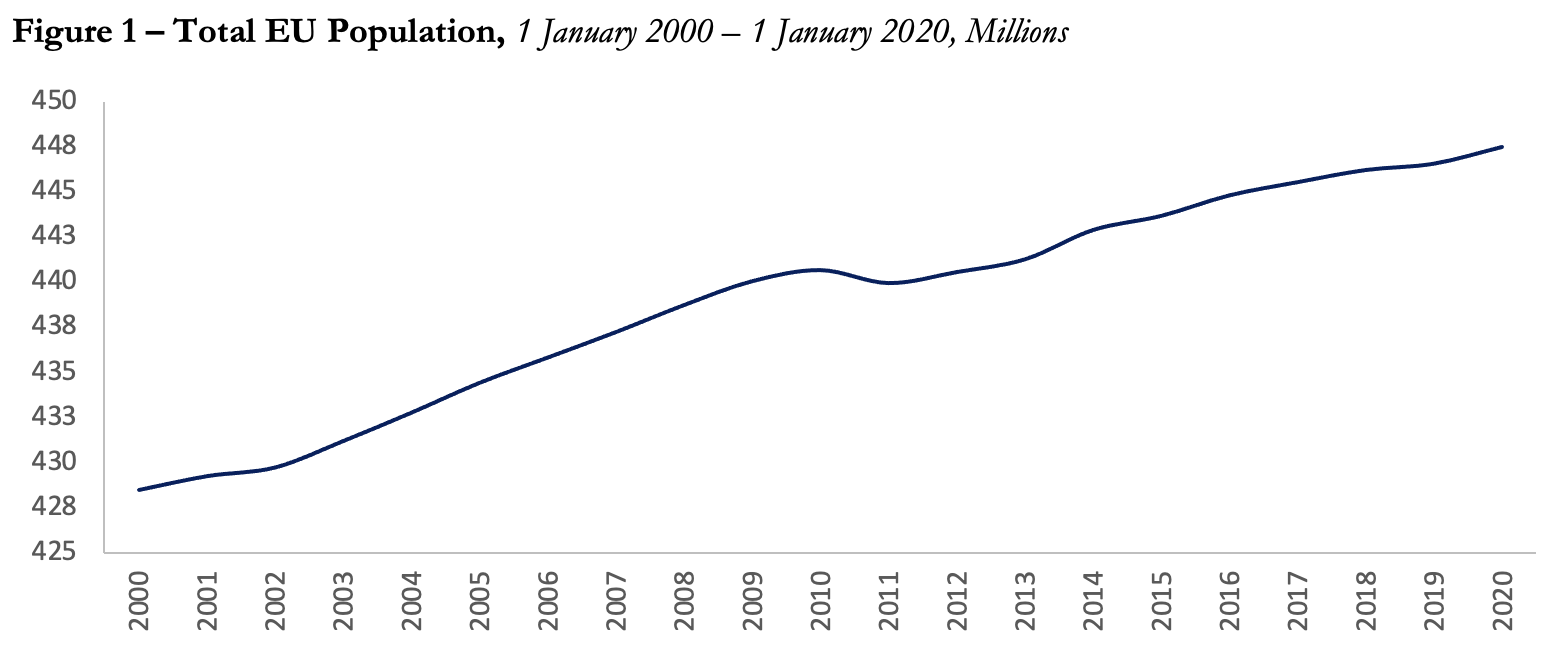 Source: Eurostat Population and Social Conditions.
Source: Eurostat Population and Social Conditions.
However, while population growth remained positive, the pace of growth has been declining over the years. The total EU population grew at an average annual rate of 0.15% between 2010 and 2019, compared to average rates of 0.27% during 1990-2009, 0.32% during 1980-1989, and close to 0.50% during the 1970s. This slowdown in the pace of growth has been fueled by declining births since the 1960s, as shown in Figure 2. At the same time, the number of deaths has been increasing. The number of births in the EU declined by an average annual rate of around 0.79% during the period of 1961 to 2019, while the number of deaths increased by an average annual rate of around 0.51%. Indeed, the natural change in the population – defined as the difference between the number of births and deaths – has been negative since 2012, as the number of mortalities exceeded that of live births.
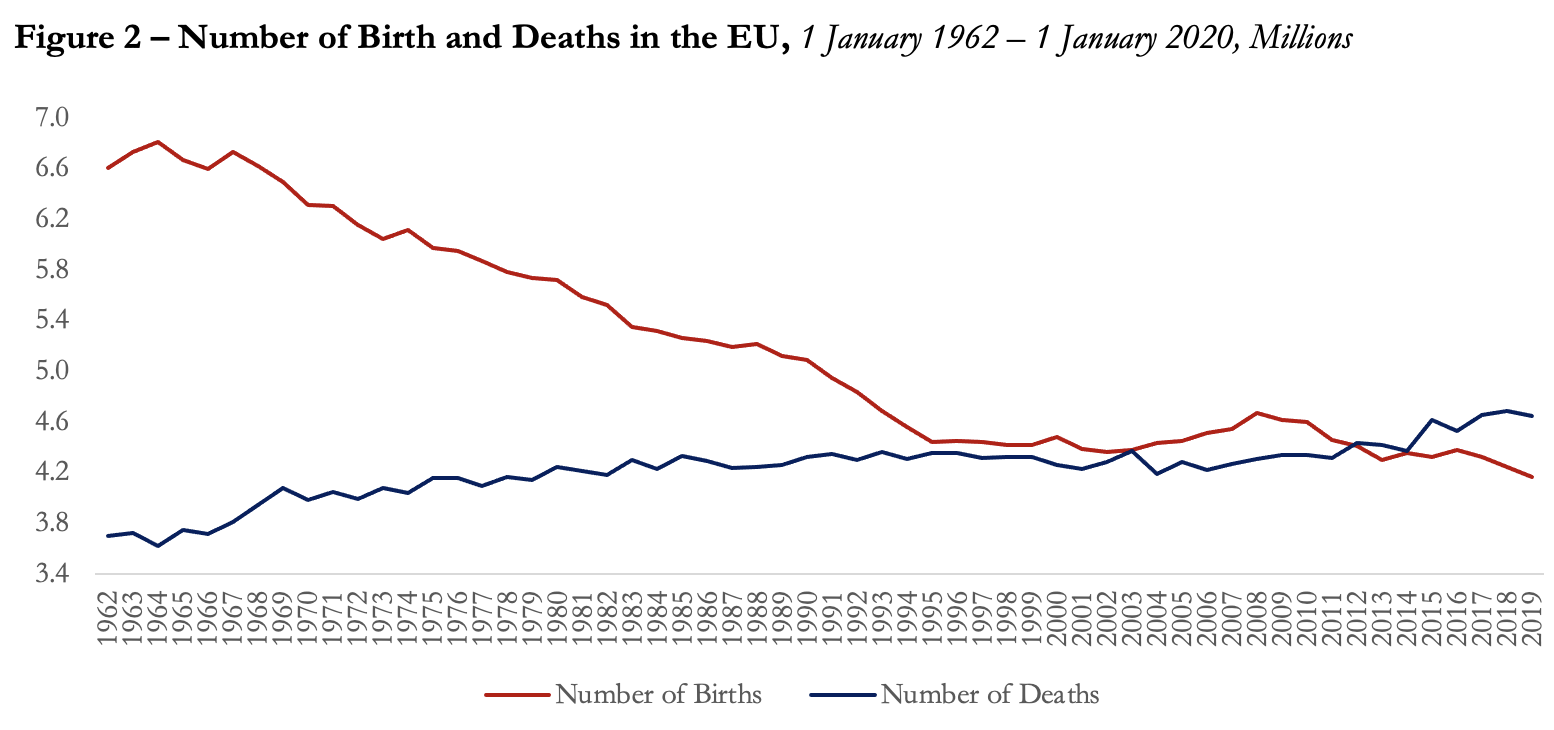
Figure 3 below summarizes the key EU population demographics in 2019. The EU is characterized by a low fertility rate, which stood at 1.5 live births per woman in 2019, almost half the 2.4 global fertility rate. This, coupled with a high EU life expectancy, has led to an aging population and a low crude birth rate of 9.3 births per 1000, failing to surpass the 10.4 crude death rate. Looking at the EU age profile, the proportion of those 65 years of age or older are almost double the world share, standing at 20.2% and 9.2%, respectively. Similarly, the EU has a median age of 43.7, compared to only 29.5 globally. These demographics indicate an aging population where declining birth rates are unable to sustain positive natural population growth.
 Source: Eurostat Population and Social Conditions.
Source: Eurostat Population and Social Conditions.
Certainly, as can be seen in Figure 4 below, the old-age dependency ratio has been rapidly increasing since 2001, as the number of those 65 years of age and above has been increasing faster than the working-age population (those between 15 and 64 years of age). In 2019, the EU dependency ratio reached 31.6, almost two times the 14.2 global ratio.
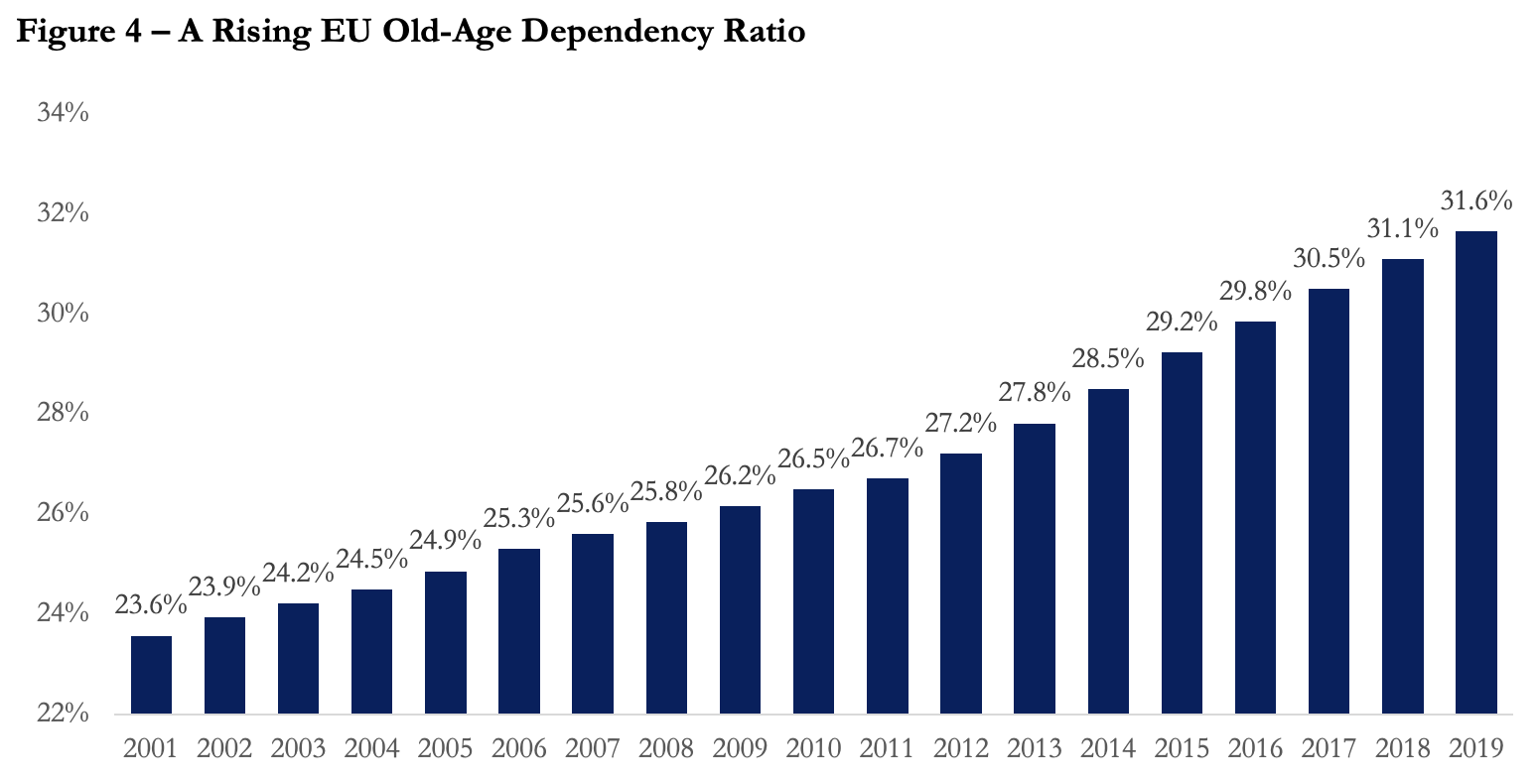 Source: Eurostat Population and Social Conditions.
Source: Eurostat Population and Social Conditions.
So, what was feeding the positive population growth prior to the pandemic?
With the negative natural population change, the only factor that has been fueling population growth is net migration. As depicted in Figure 5, the contribution of net migration to the EU’s population change has become increasingly significant over the past several years. In 2019, the number of immigrants to the EU from outside the region reached 2.7 million, nearly double its 2013 value. Conversely, the number of EU citizens emigrating outside the bloc declined by 7.4% during the same period, totaling 1.2 million in 2019.
 Source: Eurostat Population and Social Conditions.
Source: Eurostat Population and Social Conditions.
Pre-Pandemic Demographics in Different EU Countries
While most EU countries are characterized by an aging population and low fertility rates, differences in extremities do exist between individual member states. To gain a comprehensive understanding of the pre-pandemic population dynamics in the EU, this section will focus on five member states: Germany, Spain, Italy, France, and the Netherlands. The data presented in Figures 6 and 7 below will guide this discussion.
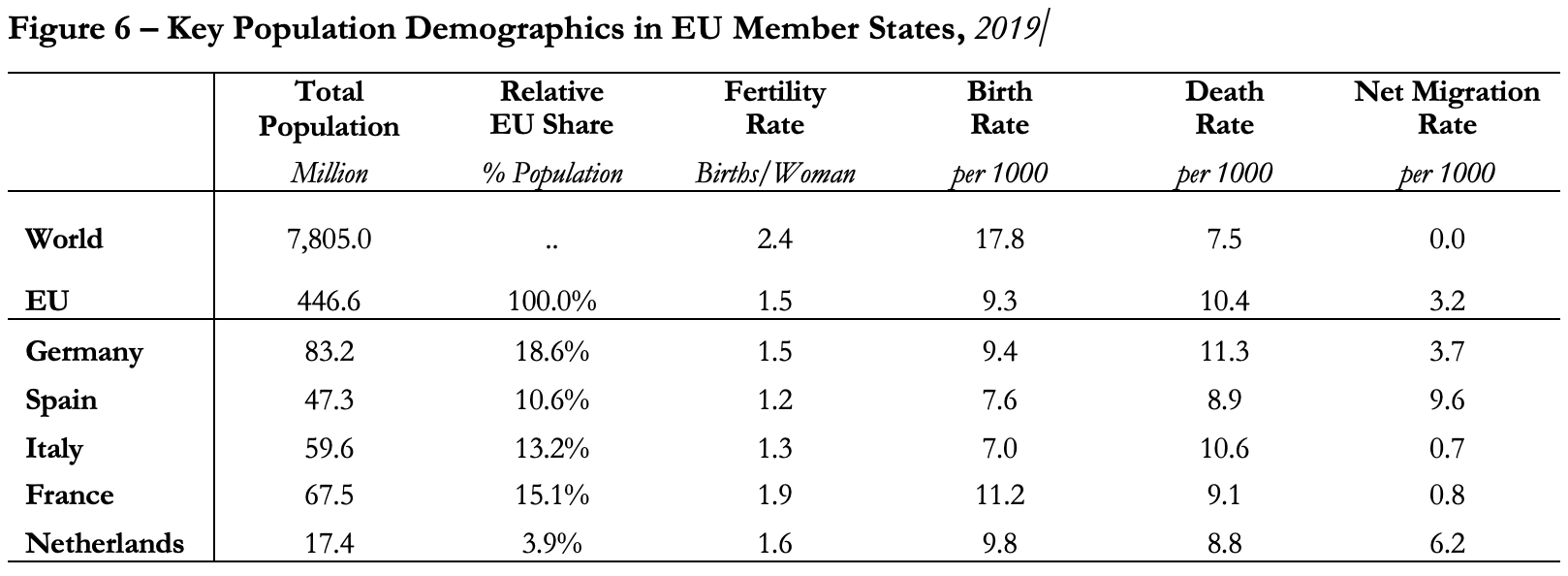 Source: Eurostat Population and Social Conditions.
Source: Eurostat Population and Social Conditions.
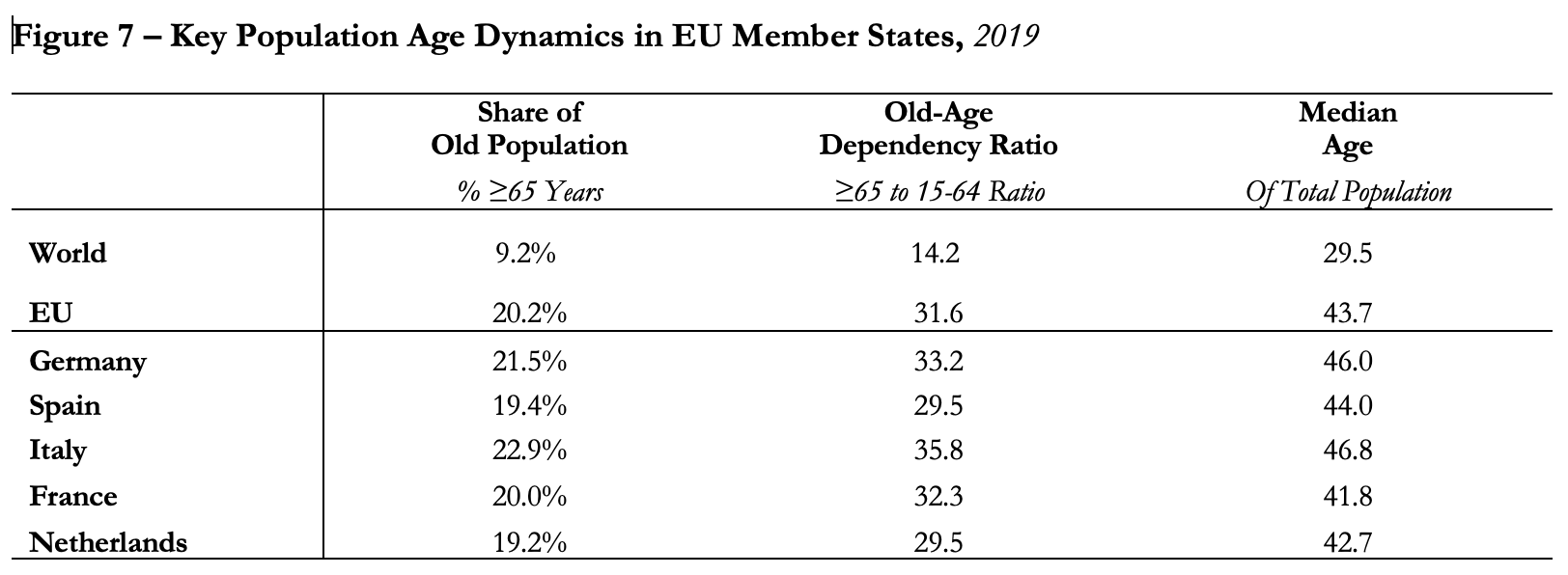 Source: Eurostat Population and Social Conditions.
Source: Eurostat Population and Social Conditions.
Germany and Spain – Uneven Population Growth, Driven by High Dependence on Immigrants
Germany is the largest country in the EU by population size. A total of 83.2 million were living in Germany on 1 January 2020, accounting for almost 18.6% of the EU population. As shown in the graph below, over the past 3 decades, population growth in Germany has been characterized by an uneven trend. Population grew by 3.5% between 1991 and 2003, to reach a peak of 82.5 million on 1 January 2003, before starting to decline.
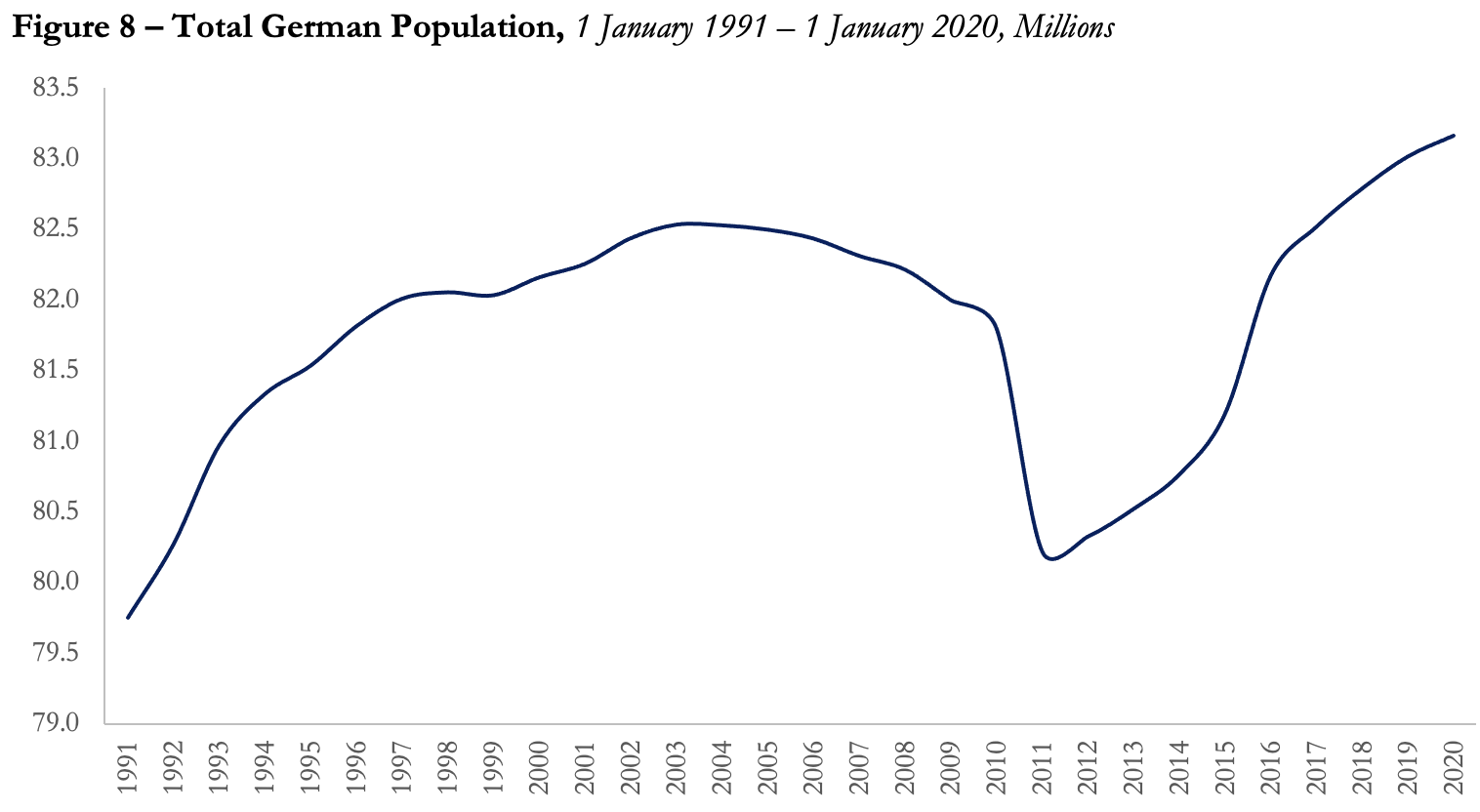 Source: Eurostat Population and Social Conditions.
Source: Eurostat Population and Social Conditions.
This population shrinkage has been driven by a negative natural population change, due to fewer births than deaths. The natural population growth rate averaged around 92,000 persons between 1991 and 2003. In 2003, the number of deaths exceeded births by 147,225 persons. Despite the positive net migration that has fueled growth in the previous years, it dropped by almost 35% during 2003 and continued to decline till the end of the decade, before recovering to its pre-2003 levels in 2010. Only then did the population trend turn its course, to increase again by another 1.7% up to 1 January 2020.
As shown in Figures 6 and 7 above, in 2019, Germany had a crude birth rate of 9.4 births per 1000, falling short of its 11.3 crude death rate. Moreover, Germany has an obviously aging population, as its 2019 median age stood at 46 years, with a 33.2 old-age dependency ratio and a 21.5% share of those 65 years and above, all of which were slightly above the EU values and much higher than the global ones. In turn, immigrants are particularly important for feeding the country’s population expansion. As shown in Figure 9 below, net migration has been the main fuel for population growth in Germany as it has continuously maintained a negative natural population change. Germany receives the largest number of total immigrants in the EU, which stood at 886 thousand in 2019 or 21% of the EU total. While crucial for maintaining a positive population growth, such high dependence on immigration might often lead to uneven changes in the population trend.
 Source: Eurostat Population and Social Conditions.
Source: Eurostat Population and Social Conditions.
As demonstrated in Figure 10, Spain has experienced a dynamic evolution in terms of its population growth. From 1991 to 2012, the Spanish population grew at an average annual rate of 0.9%, reaching its peak of 46.8 million in January 2012. However, this growth was short-lived, as the population began to decline over the following four years. Fortunately, the trend reversed in 2016, with the Spanish population rebounding and growing at an average rate of 0.5% annually during the period of 2017-2019. As of January 2020, the population of Spain reached 47.3 million, solidifying its position as the fourth largest country in the EU and accounting for 10.6% of the total population.
 Source: Eurostat Population and Social Conditions.
Source: Eurostat Population and Social Conditions.
Population shrinkage during 2012-2015 was due to a decline in the number of immigrants and a surge in emigrants, amid the deteriorating economic situation following the global financial crisis. Net migration was negative between 2010 and 2015, reaching a record low of -251,531 in 2013, as the number of people leaving the country surpassed the flow of immigrants (Figure 11). Spain is the country with the second largest number of immigrants after Germany. In 2019, Spain received a total of 750 thousand immigrants, accounting for 18% of total immigrants into the bloc. When looking at the number of EU immigrants received from outside the region, Spain holds the first position, as it received almost 640 thousand immigrants from countries outside the EU in 2019 (84% of its total immigrants).
 Source: Eurostat Population and Social Conditions.
Source: Eurostat Population and Social Conditions.
Spain is facing a demographic challenge with one of the lowest fertility rates in the European Union, registering just 1.2 live births per woman in 2019, compared to the EU average of 1.5. The crude birth rate in Spain stands at 7.6 births per 1000, with a death rate of 8.9 deaths per 1000. Given this, immigrants play a crucial role in maintaining population growth, like Germany.
However, unlike Germany, Spain’s natural population change has been in decline since 2008, turning negative only in 2015. Despite initially offsetting the loss of migrants, the declining birth rate has ultimately led to a decrease in the total population.
The population age profile in Spain is also aging, though not as severe as in Germany. In 2019, the elderly population accounted for 19.4% of the total population, with an old-age dependency ratio and median age of 29.5 and 44.0, respectively. These figures are slightly below the EU average.
Italy – A Shrinking Population, Driven by Extreme Aging
Italy is the third largest country in the EU by population size, as its total population stood at 59.6 million on 1 January 2020, or 13.2% of the total EU population. While the total population in Italy increased by an average annual rate of 0.28% between 1991 and 2015, reaching a peak of 60.8 million on 1 January 2015, it has been declining since then at an average annual rate of around -0.4% (Figure 12).
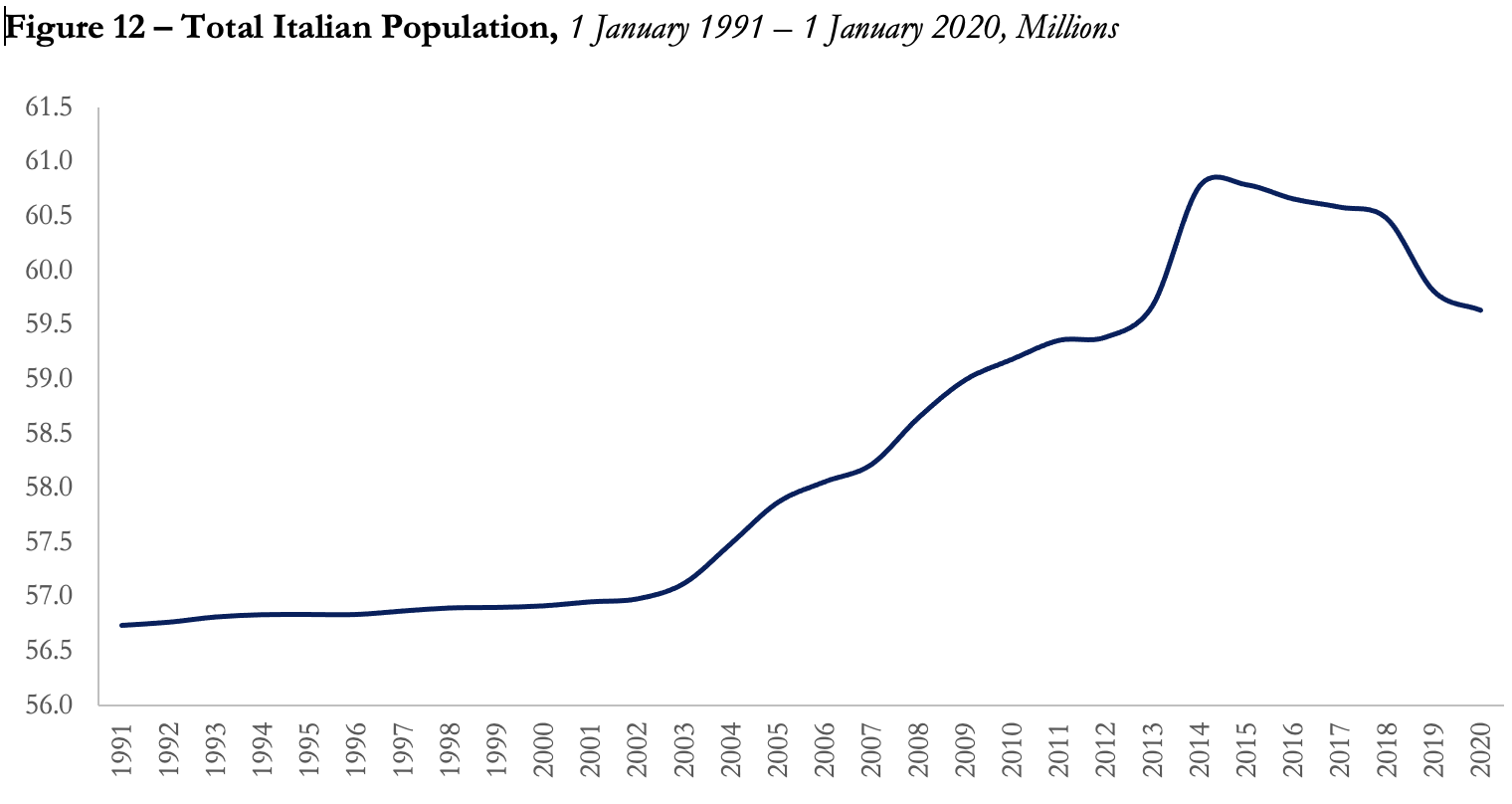 Source: Eurostat Population and Social Conditions.
Source: Eurostat Population and Social Conditions.
The declining population has mainly been fueled by extreme aging, leading to a low birth rate. Italy has the highest median age in the EU, and the fourth largest in the world, which stood at 46.8 in 2019 (Figure 13). Furthermore, the country’s population has a high concentration of elderly citizens and a significant old-age dependency ratio, recording 22.9% and 35.8 respectively in 2019, both higher than the average values within the EU.
 Source: UN Population Prospects.
Source: UN Population Prospects.
As a result of such an aging population, Italy has very low fertility and birth rates. The birth rate was 7.0 per 1000 in 2019, falling way short of the 10.6 death rate. Due to much fewer births than deaths (Figure 14), Italy’s natural population change has been in the negative territory since 1993, averaging -55,858 during the period up to 2019, and peaking at -214,333 in 2019. Despite a positive net migrant flow, it hasn’t been high enough to offset the negative natural change for quite some time.
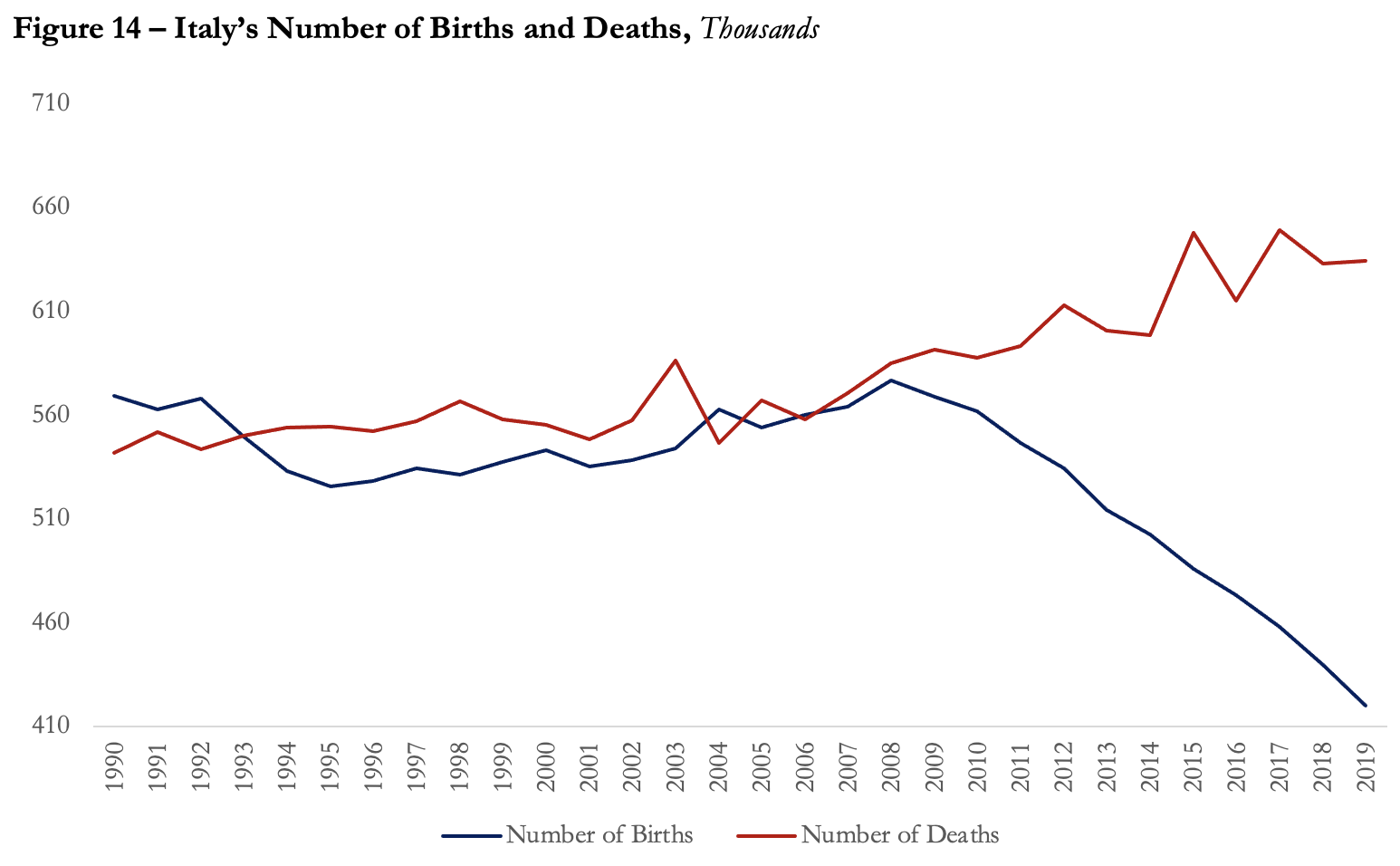 Source: Eurostat Population and Social Conditions.
Source: Eurostat Population and Social Conditions.
France and Netherlands – Steady Population Growth, Maintaining a Positive Natural Change
France and the Netherlands account for almost 15.1% and 3.9% of the total EU population, respectively, making them the second and seventh largest in the bloc. Unlike the previously mentioned countries, their population growth has been characterized by a positive and steady trend over the last 3 decades, as shown in Figure 15 below. Populations in both countries grew at an average annual rate of 0.51% between 1991 and 2019. While they did maintain a very similar growth trend, the population in France is almost four times that in the Netherlands, standing at 67.5 million compared to 17.4 million on 1 January 2020.
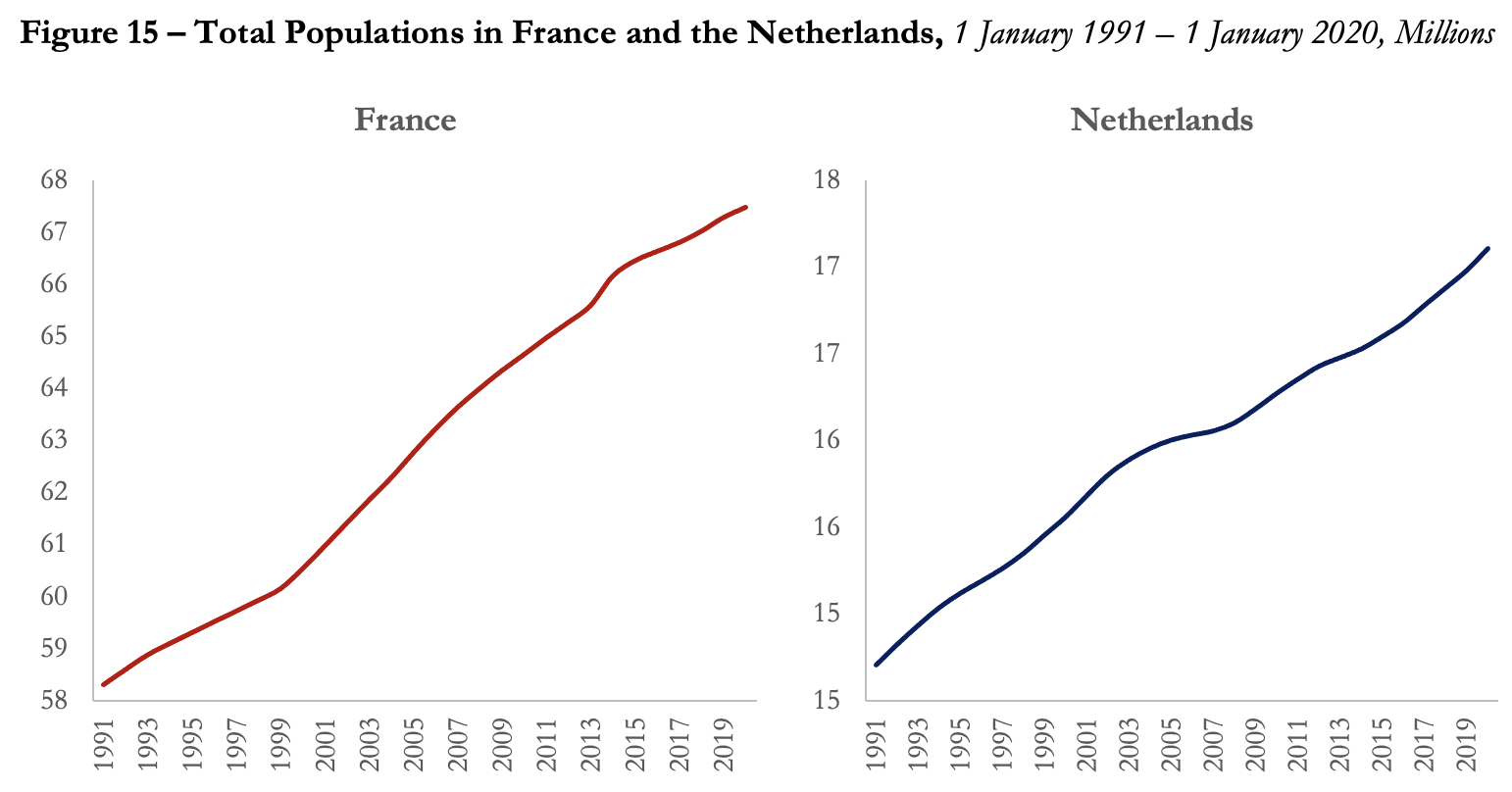 Source: Eurostat Population and Social Conditions.
Source: Eurostat Population and Social Conditions.
France has the highest fertility rate in the EU, which stood at 1.9 live births per woman in 2019, compared to an EU average of 1.5. The Netherlands’ fertility rate stood at 1.6 births per woman, still above the EU average. France has a relatively high birth rate of 11.2 compared to other EU countries. Although the Netherlands birth rate is close to that of Germany, the former’s death rate is lower, contributing to a steadily positive natural population change. Moreover, the Netherlands’ net migration rate is relatively high at 6.2 per 1000.
Despite the positive natural change in the population, France and the Netherlands still have relatively aging populations compared to global standards. For example, in 2019, the demographic profile of France and the Netherlands revealed that 20.0% and 19.2% of their populations were aged 65 years and above, respectively. Moreover, the old-age dependency ratio is around 30 and the median age is close to 42 in both countries. Like other EU countries, this puts France and the Netherlands at risk of falling into the aging trap of low fertility and negative natural population change in the future.
Population Demographics During and After the Pandemic
Due to the impact of the COVID-19 pandemic (Figure 16), the EU population decreased by 0.11% during 2020, as the total population stood at 447.0 million on 1 January 2021, compared to 447.5 million on 1 January 2020, losing a total of 484.7 thousand people. The number of deaths was particularly high in 2020 as the region recorded 5.2 million deaths, almost 531 thousand or 11% above the value in 2019. In addition, the number of births was 2.3% lower. Preliminary estimates have shown the EU population to decline for the second consecutive year in 2021, as population stood at a lower value of 446.8 million on 1 January 2022, marking an additional 0.04% shrinkage as the number of deaths were 113 thousand higher in 2021 than in 2020.
 Source: Eurostat Population and Social Conditions.
Source: Eurostat Population and Social Conditions.
While the overall EU population shrank during the pandemic, this was not the case for all member states. As shown in Figure 17 below, a total of 11 countries recorded a decline in population either during 2020 or 2021. Between 1 January 2020 and 2021, the largest decreases were in Czechia, Latvia, Italy, and Romania, followed by Croatia, Bulgaria, Hungary, Greece, Poland, and Germany. Between 1 January 2021 and 2022, the largest population declines were recorded in Croatia, Bulgaria, Latvia, Romania, and Greece, followed by Poland, Slovakia, Hungary, Italy, and Slovenia. Overall, Bulgaria, Croatia, Latvia, Czechia, and Romania were the top-5 EU countries by population loss over the two pandemic years.
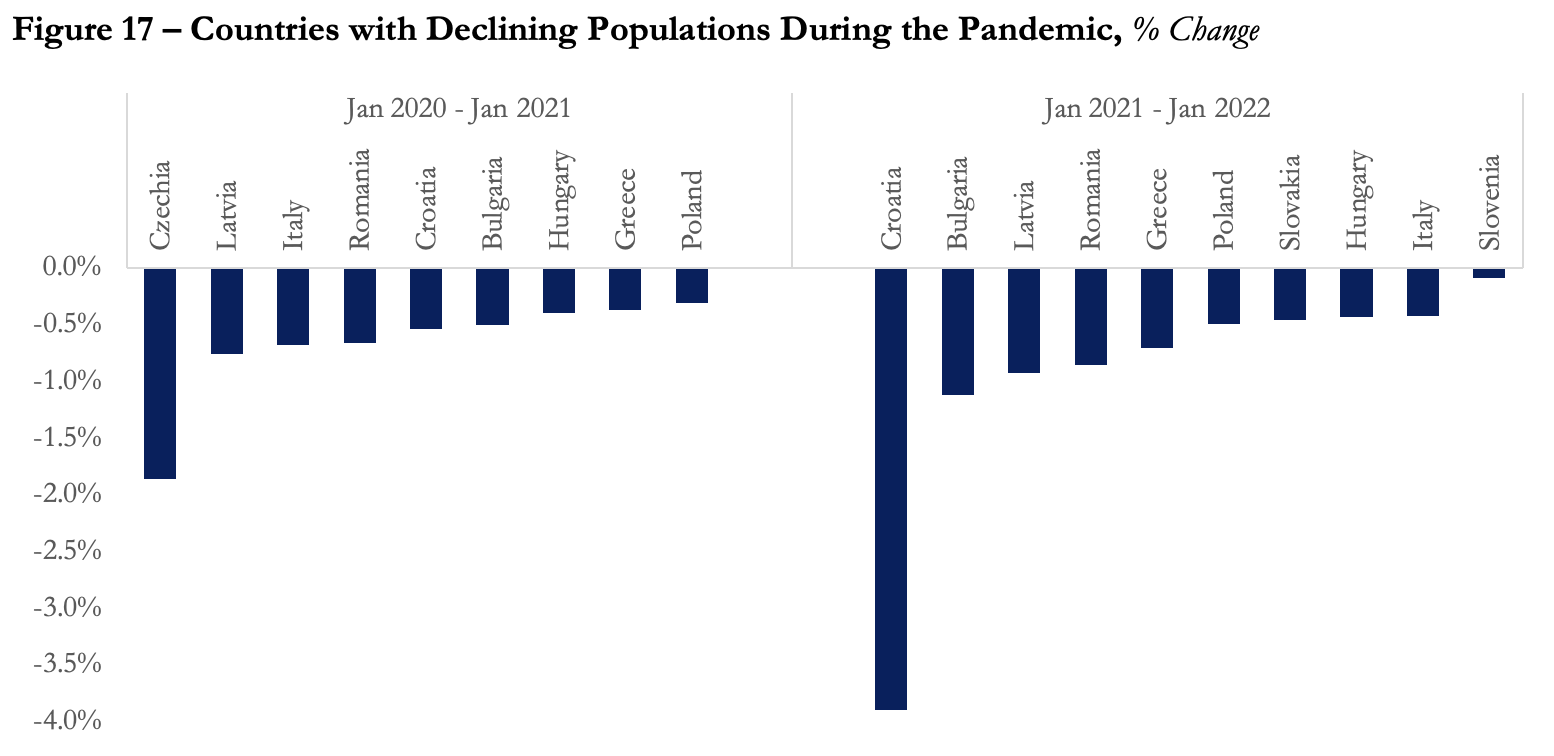 Source: Eurostat Population and Social Conditions.
Source: Eurostat Population and Social Conditions.
As shown in Figure 18 below, of the five countries studied in this report, only Italy and Germany recorded population declines during 2020, losing a total of 405.3 thousand and 11.7 thousand people, respectively, as death exceeded birth by 335.4 thousand and 212.4 thousand, lower than what net migration was able to offset. In 2021, only Italy experienced a decreasing population of 253.1 thousand, as deaths surpassed births by 309.6 thousand.
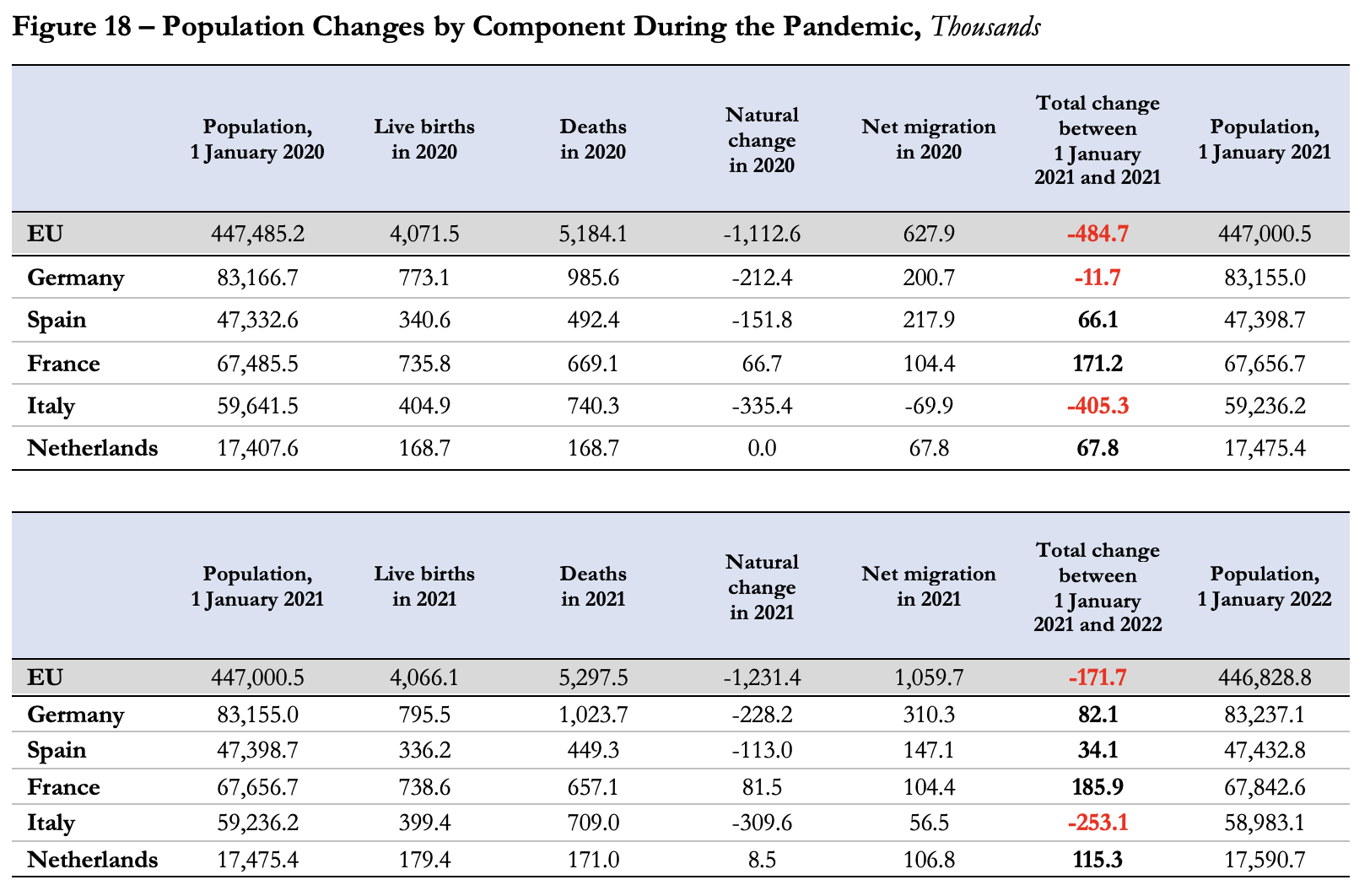 Source: Eurostat Population and Social Conditions.
Source: Eurostat Population and Social Conditions.
Future Population Demographics: Looking Forward to 2050
As shown in Figure 19, under baseline projections by Eurostat, the EU population will decrease by a total of 2.2% between 1 January 2022 and 2025, and by an additional 4.8% up to 2100. The trend sees the EU population increasing up to 2025, reaching a peak of 449.3 million, before it starts to continuously decline, reaching a total of 441.2 in 2050 (2013 level) and 416.1 in 2100 (1989 level).
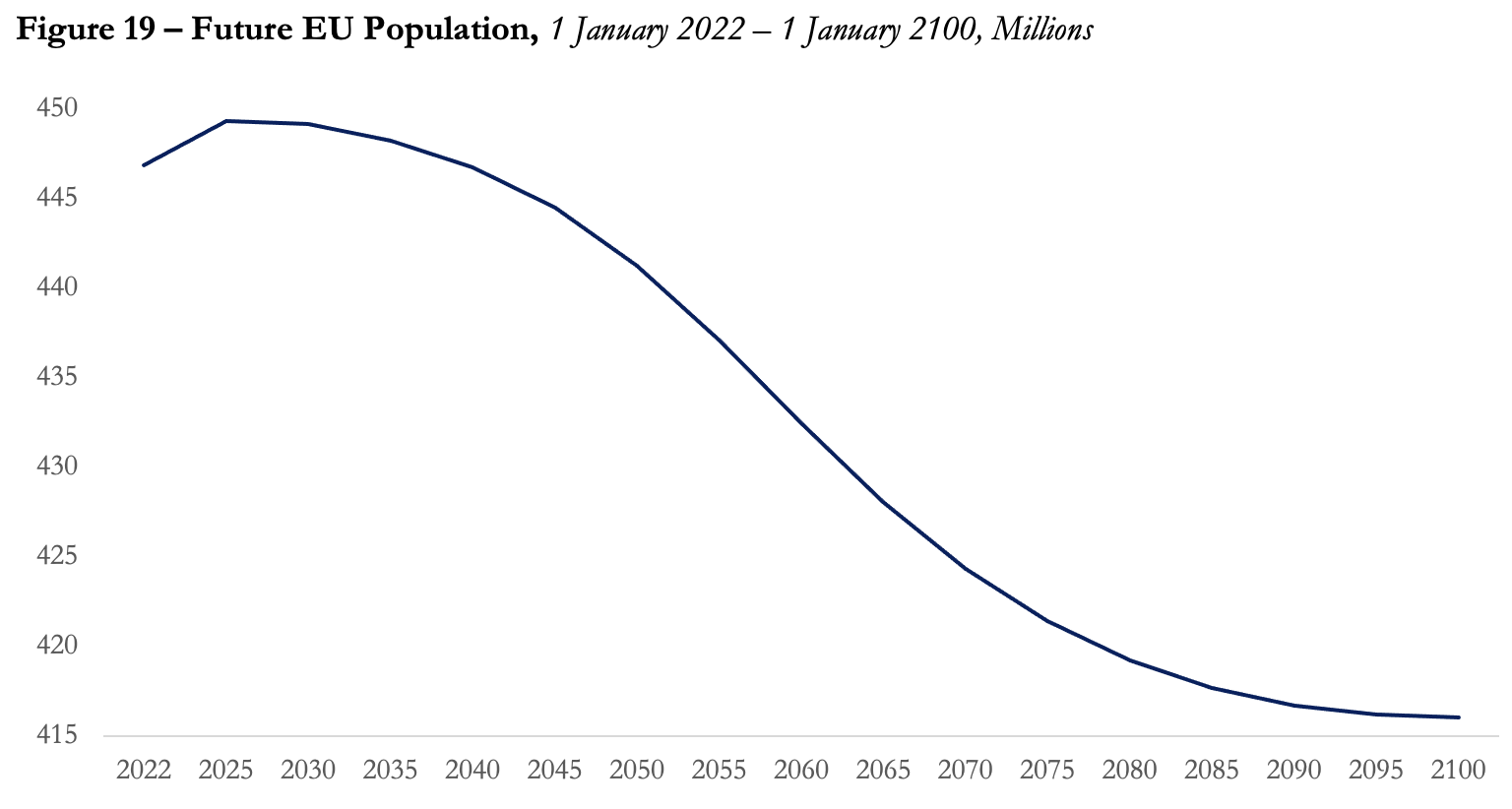 Source: Eurostat Population and Social Conditions.
Source: Eurostat Population and Social Conditions.
It should be noted, however, that Eurostat projections were based on 2020 population estimates and are yet to be estimated this year, not considering the latest declines in the 2020 and 2021 population figures. Other estimates by the United Nations World Population Prospects, forecast a faster declining EU population, which is expected to peak earlier in 2023 at 448.9 million, before steadily declining to 423.1 in 2050 (1994 level).
Regardless of the exact projected figures, the outlook paints similar stories. Due to its rapid aging and low birth rate, the EU population will shrink in the next 3 decades, and even further up to 2100. Eurostat projects a continued aging population in the future, as the EU’s median age is expected to increase to 48.2 in 2050 and 48.8 in 2100, compared to 43.7 in 2019. Moreover, the old-age dependency ratio is projected to increase from 31.6 to 51.0 in 2050 and 57.1 in 2100. The proportion of those 65 years of age and above is expected to hit 29.5% and 31.3% in 2050 and 2100, respectively, up from 20.2% in 2019. Even worse, the number of very old people, defined as those 80 years of age and above, is expected to jump from 26.0 million in 2019 (5.8%) to 50.0 million (11.3%) in 2050 and 60.8 million (14.6%) in 2100.
Overall, three main factors are projected to characterise the EU population in 2100, as depicted in the population pyramid in Figure 20:
- An Aging Bottom: a modest decrease in the young-age population due to a lower number of births.
- A Shrinking Middle: a considerable shrinkage in the working-age population, increasing their burden to sustain the dependent population.
- A Broadening Top: a large growth in the elderly population, reflecting the aging of the society.
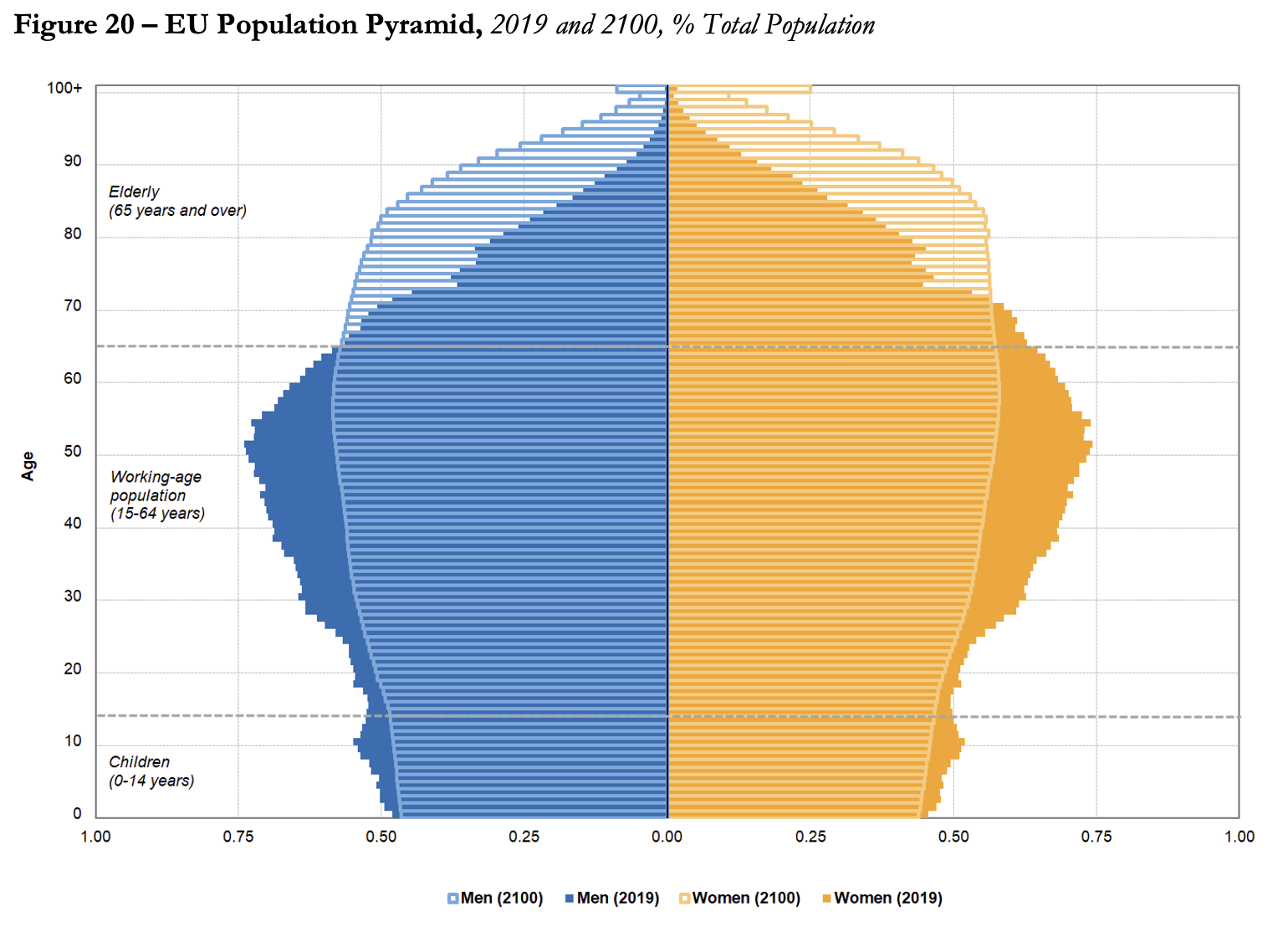 Source: Eurostat Population Projections.
Source: Eurostat Population Projections.
The population trends of EU member states vary significantly. As depicted in Figure 21, Germany is projected to experience a population peak around 2025, with a decline of 0.7% between 2022 and 2050 and a further 1.2% from 2050 to 2065. In contrast, populations in Spain, France, and the Netherlands are predicted to reach their peak between 2040 and 2050, exhibiting growth of 3-4% up to 2050 before declining up to 2065. Meanwhile, the Italian population is anticipated to have already reached its peak, due to its aging characteristics. This population is projected to shrink by 1.5% up to 2050 and by an additional 5.6% from 2050 to 2065.

What Does This Mean for the EU Economy and Can It Be Mitigated?
The EU economy is expected to face a range of challenges because of its shrinking and aging population. A natural consequence of the aging population is the decline of the working-age population. In fact, as shown in the graph below, the EU working-age population has already peaked in 2009 and has been declining by an average annual rate of 0.25% since then.
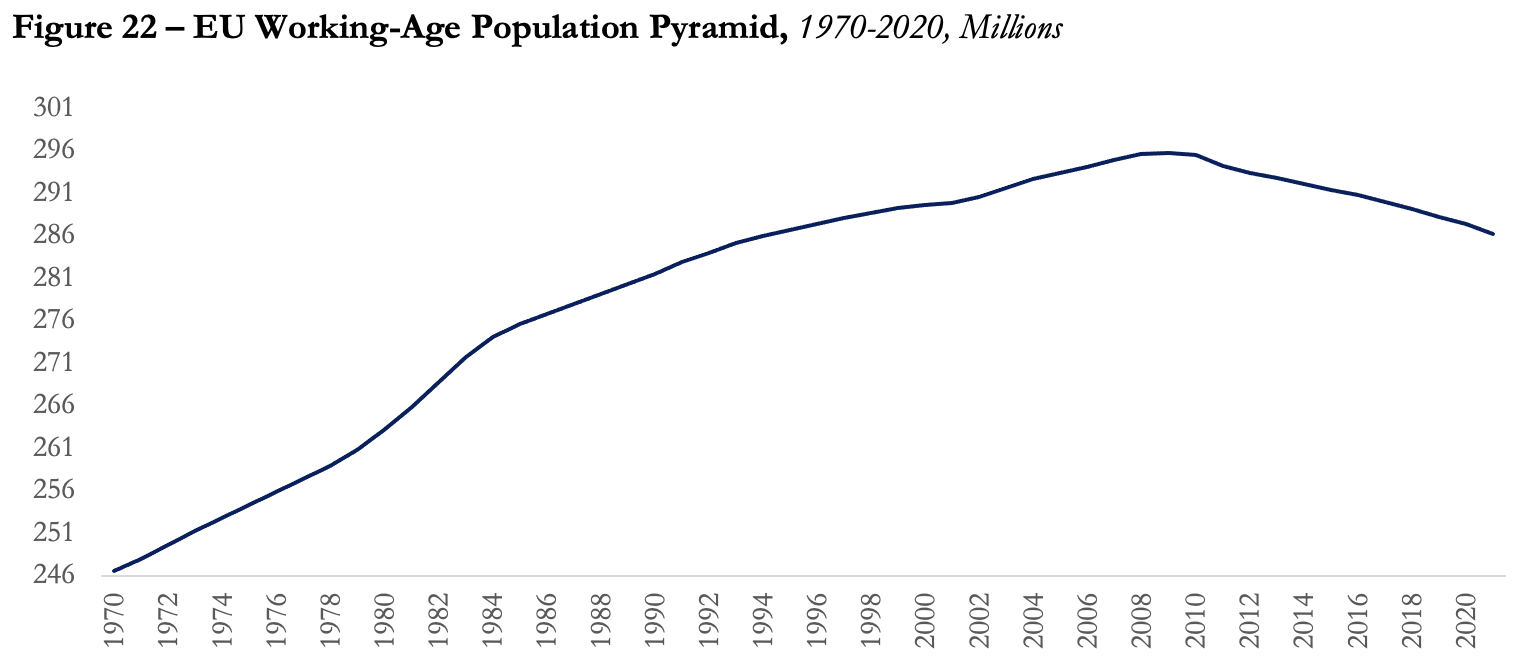 Source: World Bank’s World Development Indicators.
Source: World Bank’s World Development Indicators.
The decline in the labor force is poised to negatively impact productivity and exert downward pressure on economic growth. As illustrated by the graph below, the growth of Gross Domestic Product (GDP) has historically been largely associated with population growth. Additionally, an aging population can create larger fiscal burdens on the government. Firstly, as an increasing elderly population becomes dependent on the contributions of fewer workers to sustain these systems, government pension liabilities will need to increase. Secondly, a higher prevalence of chronic diseases is associated with an increase in the larger number of older people, which will necessitate more public spending on healthcare in general and on long-term care in specific.
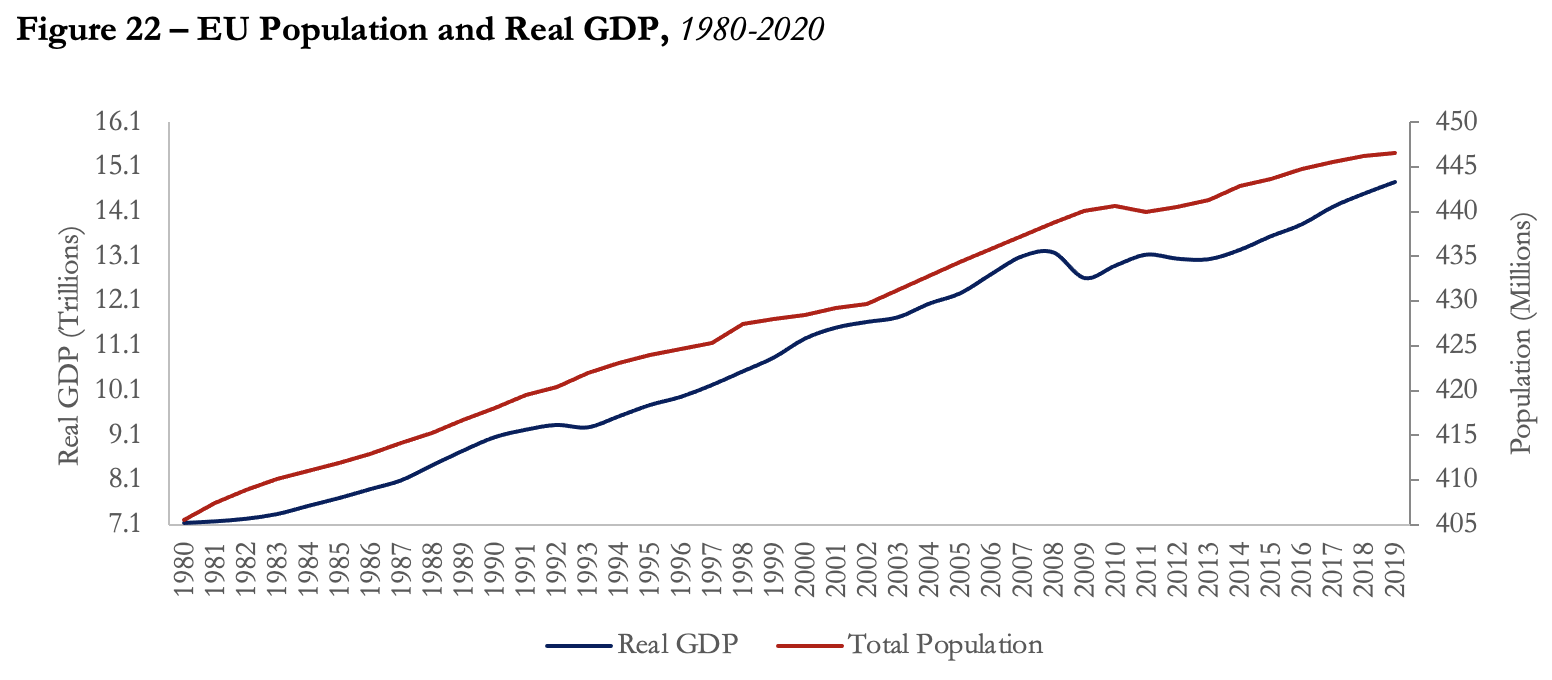 Source: Eurostat Population Projections and World Bank’s World Development Indicators.
Source: Eurostat Population Projections and World Bank’s World Development Indicators.
Appropriate and prompt policy responses are necessary for the EU to mitigate the negative impacts of its shrinking and aging population. It is important that the government encourages individuals to participate more and longer in the labor force, which if done correctly, according to a World Bank report, dependency ratios could stabilize. On one hand, policy changes such as increasing the retirement age, which remained relatively stable in most countries for the past several decades, could help stabilize the old-age dependency ratio and reduce the decline in the labor force. On the other hand, incentives should be carefully put in place to increase labor force participation. Fiscal policies should be designed in a way that would not discourage but rather encourage people to work. For example, policies such as neutral tax treatment for a second household earner have been shown to increase female labor force participation. Some countries have also resorted to providing tax credits for parents who work a certain number of hours, to encourage them to work more. Increasing the penalties for early retirement can also encourage workers to stay longer in the labor force.
Pronatalist incentives, which increase the fertility/birth rate, would be helpful. These include policies such as more generous maternity/paternity leaves, encouraging more than one child, larger child benefits, and government-subsidized childcare. Moreover, spending on and providing affordable childcare facilities can inspire work, especially for women. In addition, encouraging work flexibility, such as through remote working, can improve labor force participation for both women and the elderly.
With a declining labor force, it is also crucial to invest well in human capital development, to improve its productivity. According to the World Bank Chief Economist for Europe and Central Asia, Hans Timmer, “A long-held belief is that aging populations tend to go hand-in-hand with economic decline, however, a smaller size of young cohorts opens the opportunity to equip them with better quality education and more capital, ultimately boosting their productivity.”
As the population ages, it would also be important to shift the healthcare spending and provision model to one that emphasizes preventive rather than reactive care, for early detection and the reduction of chronic healthcare diseases. Technological innovations, such as new drugs that improve the quality of life and slow the aging process, are also important.
Finally, even if the correct policies are put in place, the effects of an increased fertility or birth rate would only be realized over multiple years. In the meantime, it might be necessary to relax some of the barriers to international migration from regions with large working-age populations. Selectively targeting skilled foreign labor might help expand the EU labor force and add to its productivity.
Conclusion
Simply put, economic growth is productivity multiplied by the population of workers working. With an aging population, declining birth rates, and declining size of the labor force, the EU is seeing a grim economic growth future.
However, the aging population in the EU also presents opportunities. The demographic shift towards an older population can drive productivity and efficiency, as older workers tend to have greater experience and expertise.
Like adaptation during COVID and inability to attain workers, companies will shift towards using technology, robotics and innovative labor practices to overcome the lack of labor. This will drive an increase in productivity. AI is a great example of a technology we are only on the cusp of implementing into the economy and as a driver of productivity. Additionally, the aging population presents a growing market for age-related goods and services, such as healthcare and long-term care, self-driving cars and the bioeconomy.


